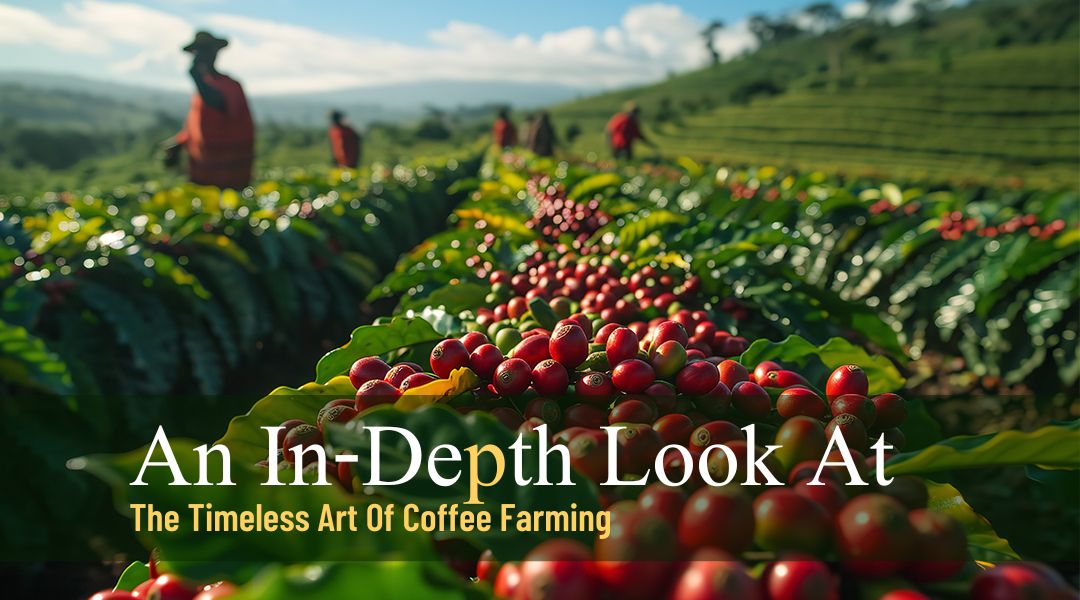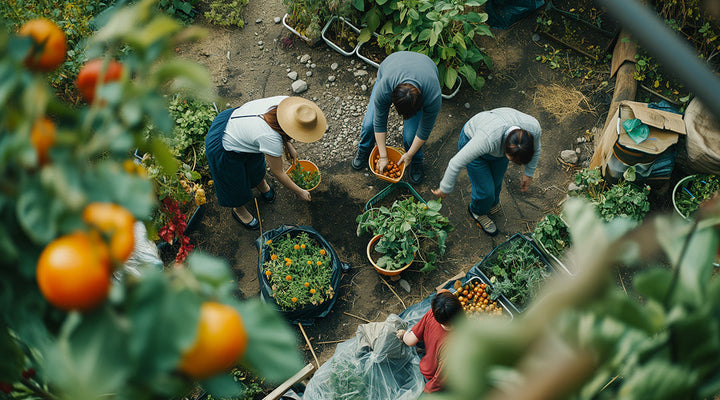
An In-Depth Look At The The Timeless Art Of Coffee Farming - What It Takes To Make Your Cup Taste Great
Here in the midwest, it’s planting season for those looking to grow their own fruits, vegetables, flowers, etc.
And, if you’ve ever raised your own produce, you know that each and every detail in the planting and growing process is vitally important to the taste, texture, and even nutritional value of the crop.
Of course, the same is true of coffee!
Coffee does begin as a fruit, afterall, since those beloved beans, before reaching your cup, begin as cherries on a coffee shrub.
What you experience with each sip - the smoothness, balance, boldness, and those subtle tasting notes specific to each variety of coffee - is all a result of the planting, growing, and harvesting process of those cherries.
Bright and floral. Chocolatey or nutty. Rich caramel. Notes of figs and sweet fruits.
Have you ever wondered how each type or even roast of coffee comes to have such unique flavors?

One misconception is that these flavors are added to the coffee beans once harvested and processed. But, this is simply not true.
Those descriptions listed above are some of the most common tasting or flavor notes in coffee, and these occur naturally depending on the variety of coffee, the environment and/or region where the coffee cherries mature, as well as many other delicate measures which all come together at the hands of coffee farmers around the world.
So then, what does it take to grow coffee, especially great tasting, clean, healthy coffee?
And, how does the environment, climate, or region where coffee is grown affect the final tastes you experience with each glorious sip?
Or, to bring this to a personal level, what does the life and dedicated duty of a coffee farmer look like?
Let’s find out…
The Timeless, Tasty Art Of Growing Coffee

We have several talented hands and knowledgeable minds that dedicate their lives to growing Lifeboost coffee on small family coffee plantations in various parts of the world.
Most of our coffee, however, is grown high in the rainforest mountains of Central America.
And, if you’ve been a Lifeboost customer for very long, you know our practices vary from most coffee companies in that,
- our farmers avoid deforestation
- our coffee is grown amongst native plant and animal life to enhance biodiversity while also benefiting from all that nature can bring to each cup
- Lifeboost coffee is grown at high elevations which slows maturity, allowing our coffee beans to absorb a greater amount of nutrients in the process
- our coffee farmers never use harsh chemicals in any part of the growing or harvesting process
- our coffee is delicately spring water washed and thoroughly dried to ensure no molds grow throughout processing
- our coffee is free of molds, mycotoxins, heavy metals, etc.
- Lifeboost coffee is 3rd party tested for each of these (above) and hundreds of other toxins which can be lurking in conventionally grown beans
But, despite all of these nuanced details, Lifeboost coffee does begin like all others…with a single coffee bean.
Without being dried, roasted, or ground to brew a tasty cup of joe, the coffee bean is essentially a seed. Truly, you could think of this like any other fruit, where the seed of the fruit is housed beneath a fleshy outer layer.
In the case of coffee, this fruit is called a cherry. So, in those terms, just as a bing or rainier cherry has a small dark seed beneath a layer of juicy, plump, fleshy fruit, a coffee cherry is similar.
And, when growing coffee, that seed hidden beneath this outer layer is where the journey to your mug begins.
Then, the growing/farming process goes a little something like this:
Prior to planting the coffee seeds, farmers dig small holes throughout the rainy or wet season to loosen the soil, then the unprocessed coffee bean, or the seed, is planted in rows.
And, as we mentioned above, in the case of Lifeboost coffee, these rows are planted near and amongst native plant life.
In the beginning stages of growth, our farmers pay careful attention to even the smallest details, ensuring the seeds are well watered and adequately shaded from the harsh sun.
In this first stage, much patience and dedication is required from coffee farmers as it can take 3-5 (or more) years for coffee trees or shrubs to finally bear fruit.
Typically, a coffee plant goes through 3 stages - this initial growth phase where the plant is established from a mere seed, carefully monitored and tended to until it finally produces fruit.

Then the plant enters what is known as the productivity stage, where coffee shrubs produce plump, firm coffee cherries, bestowing an annual harvest for anywhere between 15-25 years.
After these prime years, the coffee tree/shrub submits to the circle of life, declining until it is dead or is no longer able to produce fruit.
Ah, but back to those initial growing years.
Once a coffee plant begins to produce fruit, this is truly a glorious site!
For the farmers, I can only imagine they feel the same sense of pride that I saw in my grandfather when his tomato plants or fruit trees would finally shine forth with beautiful, bountiful orbs of fleshy produce.
And, in the case of coffee, this can take 6-7 months to behold (once the plant is in the mature, production stage).
First, the shrubs display fragrant white blossoms, like most flowering fruit plants.
In the case of Arabica coffee, these flowering plants are self-pollinating, meaning one less step in the farmer’s intensive labors.
After the coffee blossoms come and go, however, the cherries finally appear.
At first they are small, hard, green oval-shaped fruits that grow in long clusters along the branches of the plant.
But, after months of delicate tending and patient waiting, farmers recognize ripe, ready for harvest, cherries by their bright, beautiful red or yellow color (depending on the variety).
In the long months as the cherries ripen, farmers continue to monitor the shrubs, ensuring they are healthy and growing well, a process that can include watering and even pruning.
Typically, a coffee ‘tree’ can grow many feet tall, but for farmers like ours, since they hand-select, inspect, and harvest each single cherry, the shrubs are typically pruned keeping the plants at 5-7 feet.
Of course, if you’ve ever planted produce, flowers, trees, or shrubs, you know that the act of pruning serves multiple purposes, one of which is that this process also increases the amount of fruit each plant will yield. I guess you could say it’s a win-win for farmers who hand select/pick this small fruit.
And, speaking of picking/harvesting, when it comes to coffee farming, this is truly an “all hands-on deck” process where farmers gather for several picking sessions.
At this time, they carefully inspect cherry after cherry, only selecting the perfectly ripe, deeply red, plump, yet firm, oval shaped fruits.
Generally speaking, a picker rotates amongst the shrubs roughly every 8-10 days to ensure only the ripest fruits are selected.
And, this is often considered a premier process, only used for the finest, specialty Arabica beans because of how detailed and labor intensive this hand-selection practice is.
On average, a skilled, knowledgeable coffee picker may pick up to 100-200 pounds of cherries a day, an amount that typically yields 20-40 pounds of dried, roasted coffee beans.
Once harvested, basket after basket full of pristine, ripe coffee cherries are quickly sent to be processed.
The cherries can rapidly spoil once picked, so processing must occur in a timely fashion.
We’ve got many more particulars to explore regarding coffee farming, so processing details must be saved for another time.
But, to briefly sum this up, there are a few popular processing methods used in coffee production, both of which seek to dry, or physically remove, the outer fruit of the coffee cherry.
After this, including a series of washing, drying, and sometimes fermentation, all that remains of these fruits carefully grown, nurtured, and picked by skilled farmers, is a green coffee bean, ready to be roasted, ground, brewed, and enjoyed by you!
Now…
I’m sure those of you who have experience in farming or gardening may be thinking that our examination of coffee farming methods doesn’t seem very different from growing a bountiful peach tree harvest or some prize tomatoes in your backyard garden, however, this couldn’t be further from the truth.
Up until now we’ve only scanned the basics of this timeless practice, but there’s actually a lot more to this brewtiful story!
Region, Landscape, Climate, And Coffee

When it comes to growing coffee…
- soil matters
- moisture matters
- temperature matters
- region matters
All of these elements and more not only contribute to successful coffee growth, but they also play a large role in the taste of your java.
First, coffee can only grow in certain regions and climates.
This beloved bean, in plant form, only thrives in warm, balanced climates, specifically those without extreme temperatures which also provide nearby plant-life to shade these delicate plants from harsh, direct-sun conditions and potentially harmful winds.
In fact, most coffee plants can only (healthily) withstand about 5 hours of sunlight per day.
For this reason, most coffee is grown in the tropics, or what many refer to as the Coffee Belt.
This, what is known as the best region for optimal coffee growth, runs between the latitudes of 25 degrees North and 30 degrees South of the equator.
Here, especially at high elevations, average temperatures range between 65-77 degrees fahrenheit.
Temperatures above 85 degrees and below 55 degrees can be detrimental to coffee growth, so those regions which boast optimal climates are crucial.
Arabica varieties, in particular, are very sensitive to warm, humid air.
Typically, when we think of a tropical climate, we think ‘hot and humid,’ but this is exactly where altitude comes into play when growing truly tasty coffee.
You see, while tropical climates do typically boast warm and humid conditions, coffee (as already stated) indeed grows best at high elevations.
At such altitudes, coffee plants can receive the best of both worlds…warmth and sunlight exposure that is tempered, controlled, or kept in balance at such heights.
For Lifeboost coffee, growing our product at altitudes at least 5,700 feet above sea level provides the perfect climate to produce a nutrient dense bean with rich, complex flavors, and a smoothness that is unparalleled.
When grown at such elevations, the coffee cherries mature at a slower rate, allowing the fruits to absorb a greater amount of antioxidants and nutrients from the soil.
And, as you can imagine, a more nutrient-dense coffee bean is also a more flavorful coffee bean. To which we all say mmmmmm!
Generally speaking, coffee grown in Central America, due to its unique climate and regional attributes, has a bright, citrus-like acidity.
Coffee grown here is also typically described as having a smooth body, with floral, fruity, or even chocolate flavor notes.
While roasting times and temperatures can deepen or even change the final taste, coffee connoisseurs can often easily detect such attributes, which we now know are a product of the region/climate where the coffee cherries are grown.
Comparing a few other regions/climates:

- Indonesian coffees (such as Sumatran coffee) are typically described as having a more earthy flavor, with hints of spices such as cloves or nutmeg, all notes which are specific to the climate, soil, and conditions present in this region.
- Many coffees grown in Africa have a fruity or floral flavor, and some even detect a strong sweetness in such varieties.
- South America is another very popular place to grow coffee, and varieties grown here are commonly described as having chocolate, nutty, or caramel undertones (this can be true of some Central American grown coffees as well).
Of course, climate and region aren’t the only particulars when it comes to providing optimal growing conditions as well as influencing the flavor/tasting notes of our brews.
Coffee plants also require a specific landscape…well, at least I’m choosing to call it landscape, using the term as an umbrella for various conditions necessary for clean, healthy coffee to grow.
Due to high demand, many conventional coffee companies have found it necessary to create hybrid coffee plants, those which seem to buck the system, not adhering to typical needs for growth.
These plants are developed to withstand harsh, full-sun conditions, in open (deforested) fields, at lower elevations, and require serious applications of pesticides, herbicides, fertilizers, and more to maintain growth in these less than natural conditions.
And, these developments, combined with the use or application of harsh chemicals, are all necessary to mass produce a product that truly, typically, cannot flourish when/if naturally grown in this manner.
Instead, coffee (specifically Arabica coffee) needs moist, fertile, well-draining soil for optimal growth.
This is another reason the rainforest mountains of Nicaragua provide such a fertile, healthy home for our coffee plants.
The rainforest climate provides ample moisture and an appropriate temperature for growth, but here, any excess rainwater easily drains down the mountain, resulting in that needed balance while also deterring the growth of mold on the plants.
Too much sunshine is also harmful for coffee plants, and this is why no hybrid invention is needed when growing coffee in the rainforest amidst native plant life.
When coffee is grown amongst neighboring vegetation, these plants live in harmony, where the coffee plants benefit from both ample sunlight as well as gentle shade.
While not as common, some Arabica varieties can grow at lower altitudes, providing the temperatures, soil drainage, and weather permits.

However, when grown at low-altitudes, coffee plants are far more susceptible to disease, and the flavor profile of such java is nowhere near as rich, smooth, and complex as those varieties grown at high elevations.
Then, an entirely other variety of coffee is Robusta.
Robusta coffee is typically grown in Vietnam, West Africa, and Indonesia. It’s not as popular as Arabica, and this type of coffee breaks the growth-conditions mold quite a bit.
This type of coffee is considered easier to grow, less resistant to higher temperatures and poor soil conditions, and it even has a greater ability to withstand heavy rainfall.
Unfortunately, this variety of coffee and its flexibility in what’s considered optimal growing conditions, typically has a harsh, bitter flavor profile.
Personally, I think Arabica varieties truly showcase how the region, climate, altitude, and landscape contributes positively to the complexity, quality, and flavor of a brew.
I guess you could say we’ve covered a lot of ground in a little bit of time here today, but I believe this coffee farming exploration, with all its specificities, serves to explain something…
Not all coffees taste the same. And, while some aspects of flavor and mouthfeel can be attributed to roasting profiles and brewing methods, knowledgeable coffee farmers likely play the biggest role in your sipping experience.
These folks often pass down knowledge from generation to generation, where farmers learn first-hand when, how, and where to plant coffee seeds.
From there, careful eyes and expertise guide farmers in when to water, how to prune and maintain, and ultimately when to pluck each, perfectly ripe, nutrient-dense, flavor-filled coffee cherry, preparing it for equally specified processing methods to ensure you enjoy a tasty, healthy, clean sip…after sip, after sip!
Truly Revolutionary Coffee. You'll Love The Taste To The Last Drop!
Optimist Light Roast
Disclaimer: Beginning in 2025, Lifeboost Coffee primarily sources our coffee from farms in Honduras. Our practices of fair wages, sustainable growing methods-from shade to zero chemicals-all are still a part of our operations and are key to what makes our coffee health, delicious, and ethical. Only our farming locations have changed so that we can continue these ethical practices while also meeting our customer demands.

Becky is a mother, educator, and content writer for Lifeboost Coffee. She has had three years’ experience as a writer, and in that time she has enjoyed creatively composing articles and ebooks covering the topics of coffee, health and fitness, education, recipes, and relationships.
- https://www.thirdwavecoffeeroasters.com/blogs/blog/is-coffee-a-fruit-lets-get-to-the-bottom-of-this-question#
- https://counterculturecoffee.com/blogs/counter-culture-coffee/coffee-basics-tasting-notes
- https://wanderinggoat.com/pages/growing-coffee#
- https://www.ncausa.org/About-Coffee/10-Steps-from-Seed-to-Cup
- https://driftaway.coffee/how-does-coffee-grow/#
- https://www.monarchcoffee.com/coffee-curious-blog/kona-coffee-blooms-catching-the-fragrant-snow#:
- https://www.coffeereview.com/coffee-reference/from-crop-to-cup/growing-and-harvesting/flowering-and-fruiting/#
- https://perfectdailygrind.com/2021/02/a-guide-to-coffee-production-in-nicaragua/
- https://stonestreetcoffee.com/blogs/brooklyn-coffee-academy/coffee-bean-anatomy-101#
- https://us.moccamaster.com/blogs/blog/what-are-the-main-coffee-growing-regions-of-the-world#
- https://coffeearks.com/2023/04/26/the-indonesian-coffee-characteristic/#
- https://driftaway.coffee/coffee-from-around-the-world/#
- https://beans.at/en/kaffeewissen/kaffeesorten-arabica-robusta/robusta#
- References for the article to confirm data and information.










